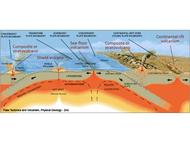Focus on the Magma
- By:
- Edward A. Reid Jr.
- Posted On:
- Feb 9, 2021 at 3:00 AM
- Category
- Climate Change
magma: molten rock material within the earth from which igneous rock results by cooling Merriam-Webster
The land surfaces of the earth and the bottom surfaces of the earth’s oceans compose the earth’s crust, a layer of rock more than 24,000 feet to as much as 210,000 feet thick. This crust surrounds the upper and lower mantle and the liquid and solid core of the earth. The temperature of the subsurface earth increases with depth from the surface to the solid core, which has a temperature of ~6,000°C.
Magma, or molten rock from the upper portion of the earth’s mantle, most commonly manifests from active volcanos, which exist both on land surfaces and on the ocean floor.

Recent research suggests that the warming of the West Antarctic Ice Sheet is, at least in part, the result of volcanic activity on the ocean floor below the ice sheet, rather than the effect of global warming.
Recent research also suggests that one of the causes of melting of the Greenland ice sheet is a mantle plume which allows magma to move up through the earth’s crust, rather than the effect of global warming.
There is also sea floor volcanic activity under the arctic sea ice, which might be contributing to diminishing Arctic sea ice extent.
There is currently renewed focus on dry hot rock geothermal energy in conjunction with explosive or hydraulic fracturing. The above graphic shows that there are areas where hot rock is present at relatively shallow depths. This rock can be fractured between two well bores, one used to inject water into the fractured hot rock and the other to transfer the resulting steam to the surface, where it is used to turn a steam turbine generator, then condensed and reinjected. Fracturing dramatically increases the surface area of the dry hot rock which is in contact with the injected water, thus increasing heat transfer to the water and thus increasing the capacity of the well pair and the generating capacity of the electric generator.
The closer the fractured rock area can be located to the mantle or to a magma pool, the higher the temperature of the fractured rock and the higher temperature and pressure of the produced steam.
Also, the closer to the mantle or a magma pool, the more rapidly heat extracted from the fractured rock can be replaced through conduction from the higher temperature source. This suggests that areas near active or even inactive volcanos might be the most productive early targets, since there are likely to be relatively shallow magma pools.
The capacity of the electric generator at a dry hot rock geothermal site is limited by the ability of the rock surrounding the fractured zone to conduct heat back to the fractured zone as it is removed by the steam generation process. Exceeding this capacity would cause the dry hot rock to cool, reducing its ability to transfer heat at temperature to the injected water.
Dry hot rock geothermal generation would be reliable and dispatchable, making it suitable for baseload generation of generation to supplement intermittent wind and solar.


